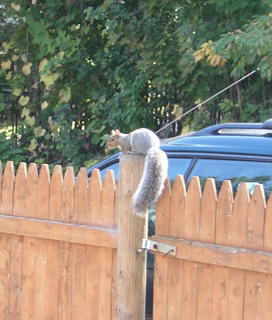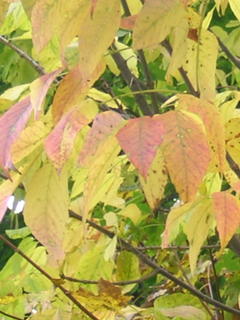Pioneers
 This red maple (Acer rubrum) has been sprouting out from underneath my front porch for two seasons now. Its seed could have come from any direction, as it is a common tree along sidewalks and in yards in this part of the country. Its brilliant red folliage makes it an attractive fall tree. It grows rapidly, a sign that it is a pioneer tree, accustomed to finding open fields and launching forests. But because it is a fast-grower, it has relatively soft and light wood. It doesn't make for sturdy furniture or flooring. Red maple is better used for hangers and other low stress applications. It's tannin was once used by native Americans as a dye, and, in desperate situations, red maple could be tapped for (teeny amounts of) sugar. This one invaded beneath the porch, poking through the sides and growing enough leaves to put down sturdy roots. I have considered transplanting it when I replace the porch next year, but that may be too much trouble for a common species like this one. It grows everywhere because it can thrive in a variety of conditions. It prefers wet or moist soils and large stands of this tree can be found in swamps, giving it one of its monikers, swamp maple. But it can also be found on upland and dry soils. In the lowland swamps, these trees turn in mid-August. This one is just beginning to turn now. It's persistence has endeared it to me and it will survive another season.
This red maple (Acer rubrum) has been sprouting out from underneath my front porch for two seasons now. Its seed could have come from any direction, as it is a common tree along sidewalks and in yards in this part of the country. Its brilliant red folliage makes it an attractive fall tree. It grows rapidly, a sign that it is a pioneer tree, accustomed to finding open fields and launching forests. But because it is a fast-grower, it has relatively soft and light wood. It doesn't make for sturdy furniture or flooring. Red maple is better used for hangers and other low stress applications. It's tannin was once used by native Americans as a dye, and, in desperate situations, red maple could be tapped for (teeny amounts of) sugar. This one invaded beneath the porch, poking through the sides and growing enough leaves to put down sturdy roots. I have considered transplanting it when I replace the porch next year, but that may be too much trouble for a common species like this one. It grows everywhere because it can thrive in a variety of conditions. It prefers wet or moist soils and large stands of this tree can be found in swamps, giving it one of its monikers, swamp maple. But it can also be found on upland and dry soils. In the lowland swamps, these trees turn in mid-August. This one is just beginning to turn now. It's persistence has endeared it to me and it will survive another season.The threads of the conservative coalition's cloth is giving out at the seams and in its very weave. Yet, still, we wait for the emergence of a new dialogue. Some have argued that all the appearances of power are just that, appearances. The dirty secret of modernity, they argue, is failure. Persistent, regular, unavoidable, anticipatable, failure. Power did not derive from rational planning, it was usurped from ordinary people, such that they ever had it, by extraordinary institutions of private wealth and gain. These are merely its latest days. We have moments now and again, cracks, like you might find in fault zone rocks, openings under the porches where something else more common might send out a shoot and flourish in the sun, pressing down roots into moist soil and fill. We need the red maple of democracy to sprout. The miracle of seeds.




